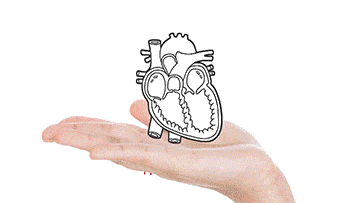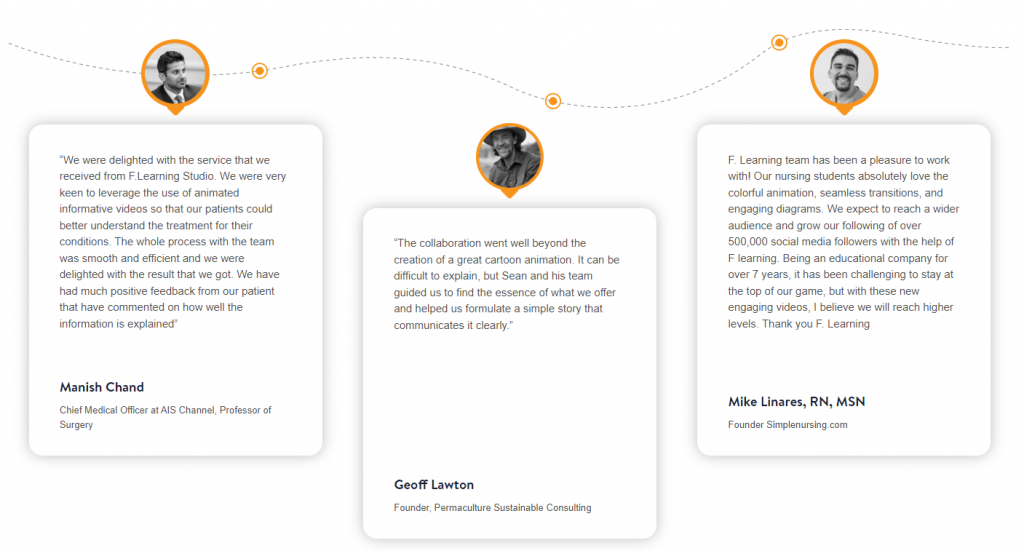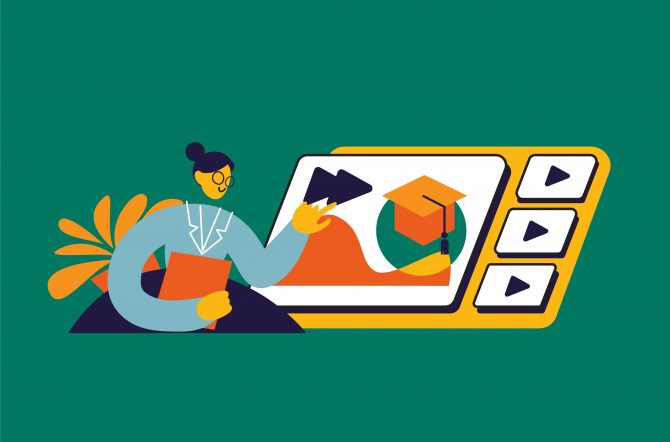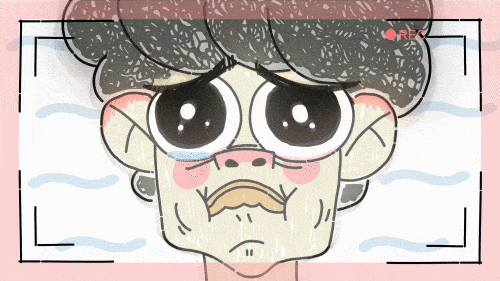Good to know that you choose animation videos for the next project. However, there are many things between before you have a good animation video – like “What are the best types of animation I should go for?”. Over the years, F.Learning has seen many issues – how to visualize knowledge with animation, how to engage customers with animation, how to optimize the budget for animation, etc. The issues seem complicated, but there is only one core one: choose the type that best fits your audience. Here’s the guide for that.
5 Different Types of Animation for Your Projects
You will see a quick peek into each type and when the best time to use it for your projects is. Then, you can choose the most suitable one to work with animated video production companies that offer rapid eLearning services.
- Whiteboard animation
- Motion graphics animation
- Hand-drawn animation
- Stop-motion animation
- 3D animation
1. Whiteboard animations
As its name suggests, whiteboard animated video includes hand-drawing images/illustrations on a white background. With a nice narrator voice and good images, you can explain various complex concepts, even medical lessons.

What are whiteboard animation’s features?
- Simple illustrations with minimizing colors (from 2-3 colors)
- Simple motion generated by the computer as motion graphic animation.
- Affordable prices (cheaper than producing motion graphics)
Choose whiteboard animation if:
- You don’t have a huge budget for creating animation
- You don’t emphasize much on the illustrations as long as it can visualize the content
- You want to transform text-based content (ex: eLearning content) and visualize an invisible part of your content
And if f you’re looking to improve patient education through whiteboard animation, check out this our article: Medical Whiteboard Animation: Best Way to Improve Patient Education.
Make your online and hybrid course more engaging with simple animation guide, why not?
Ultimate Guide to Make Animated Educational Videos

2. Motion graphics animations (Character and Non character animation)
Motion graphics animation is the most commonly used, from eLearning to marketing/branding projects. Our clients love it because it helps excite the audience and explain complicated concepts.

How to identify it?
- Colorful graphics, characters, and illustrations that could visualize any type of content
- Simple motion effects that are generated by the computer
- Usually combined with audio (sometimes audio could be the dialogue of characters)
- Storytelling methods that deliver the content by telling a story.
You should use motion graphics animation when:
- You have to explain difficult or abstract concepts that need simplification (such as Math calculations or scientific processes)
- You want to apply the branching scenario technique in your video for a better understanding
- The video doesn’t require a pretty smooth movement
- You look for a production process that is time-saving and cost-effective
Additionally, motion graphics can be particularly effective in finance video production, where complex financial concepts need to be broken down and presented in an engaging and easily digestible format.
Recommend reading:
- 15 superb animation videos for eLearning purposes
- 8 best animation videos for your branding and marketing purposes
- Rapid eLearning Services: 9 Best-pick Companies in 2024
3. Hand-drawn animations
Among the types of animation, this one is similar to traditional cartoons that you’ve watched on Cartoon Network. In short, hand-drawn is often referred to as ‘high-quality and luxury animation,’ as animators have to draw every frame of the scene and meticulously manage the movement for each frame. If you’re interested in how to create eLearning videos using this style, understanding the nuances is essential.
What does a hand-drawn animated video look like?
- Pretty smooth movements created from 15-24 frames for one second
- Usually come with a unique and premium design style
- Costly and time-consuming to produce one minute (can range from $3000 to $50000)
Come to hand-drawn animation if:
- You have a huge budget
- You want to express your personality or brand identity in the animation
- You want to stand out in the market and beat the competition.
4. Stop-motion animation
Although it isn’t trending now, stop-motion animation is still showing its power in education, especially in in-class teaching.
The advantages of stop-motion animation:
- Easy to do and quick to create with very basic movements made by hand-changing and camera-capturing.
- Stimulate the creative mind of the video creator in storytelling
- Various animated subjects with flat materials (printed paper/ photographs/ drawing images)
You should opt for stop-motion animation in case:
- You have a tight budget.
- You have in your hand a proper camera and experience in recording
- You can use basic video edit software to add some effects to make your video looks better
Additionally, if you’re looking to elevate your project, consider hiring an animation studio for hire to bring professional expertise and creativity to your stop-motion animation endeavors.
5. 3D animation (digital 3D video)
More luxurious, and more premium than hand-drawn animation, it’s 3D animation. When comparing 2d vs 3d animation, 3d is a better version of 2D motion graphic animation.
3D animation is best for your projects when:
- The subjects need realistic context with high accuracy in visualization (eg: engineering training, medical surgery)
- You don’t struggle with time and budget constraints.
- You invest for a long-term campaign with a specific vision of using animation so high production cost isn’t much of a matter (such as brand identity, point of differences)
However, in fact, primary education doesn’t include much-complicated knowledge relating to engineering or surgery. Therefore, it could be a waste to create a 3D animated video for eLearning purposes. That’s why 2D videos usually come as the ideal choice to adopt animation in primary teaching.
3 Criteria to Find the Best Types of Animation
Each type comes with its own advantages and drawbacks, so it’s hard to answer “which type of animation is best”. It all depends on your purpose, budget, and timeline. So check out to find out which type matches you well.
1. Define your purpose
Are you making animation videos for eLearning purposes? Do you want to increase sales? How about raising public awareness or capturing the audience’s attention? These questions affect the aesthetic level of types of animation.
For example, if you make an animation video for eLearning courses, that means your main purpose is to visualize knowledge engagingly, so motion graphics or 2D animation with simple motion is the best for that, like the below example:
In terms of marketing or branding purposes, you may need hand-drawn animation to capture audience attention and become outstanding among competitors:
Recommend reading:
2. Define your budget
The 5 best types of animation come with different price points. Thus, it’s better to research the quotations from different studios for different types of animation and compare their quality to balance your cost. If you have a fixed budget, you can contact F.Learning Studio. We will consult you on how to get the best animation types within your money.
Recommend reading:
3. Define your timeline
Depending on the complexity of animation types, the production times are different. The time you launch animation videos has a close relation to your learning/ business goals. Thus, be aware of the production timeline of animation types to schedule your plan.

Why Work with F. Learning Studio
Proficiency in a Wide Range of Animation
Animation is our strength and passion. Being an expert in the field, F. Learning Studio specializes in different types of animation, including whiteboard animation, motion graphics, and frame-by-frame animation. These styles are tailored to meet specific needs in industries like eLearning, corporate training, healthcare, and branding.
A Proven Track Record
F. Learning Studio has a proven track record of success, with a portfolio of satisfied clients including King’s College, Stanford University, WWF… Our visual effects and animations have helped organizations across industries achieve their goals, whether it’s raising awareness, simplifying complex concepts, or improving engagement in learning and training.
Strong Communication
At F.Learning, we’re all about making sure your project is awesome. We’ll work with you, hand-in-hand, to figure out exactly what you need and what you want to achieve. Plus, we’re super easy to work with, always keeping you in the loop and making sure we’re on the same page throughout the whole process.

Conclusion
Understanding different types of animation is the first step to bringing your ideas to life. However, it’s OK if you can’t identify the different points between them, or are not sure which one suits you best. That’s when you should go for expert guidance like F. Learning Studio. Contact us now and we can show you how animation can upgrade your content!
- WhatsApp: (+84) 378 713 132
- Email: [email protected]
- Fanpage: https://www.facebook.com/f.learningstudio
- LinkedIn: https://www.linkedin.com/company/f-learning-studio/
Read Further:
- How to write a good script for animation video
- F.Learning animation production process: How we create an effective animation video
- Create storyboard for animation video

Sean Bui, the founder and creative director of F.Learning Studio, is a respected leader in the e-learning and multimedia production industry. With over 10 years of experience, he has dedicated his career to helping organizations create engaging and impactful learning experiences.
Under his leadership, F.Learning Studio has grown into a trusted partner for organizations in the education, healthcare, and corporate training sectors, producing over 2,000 minutes of educational animation.





